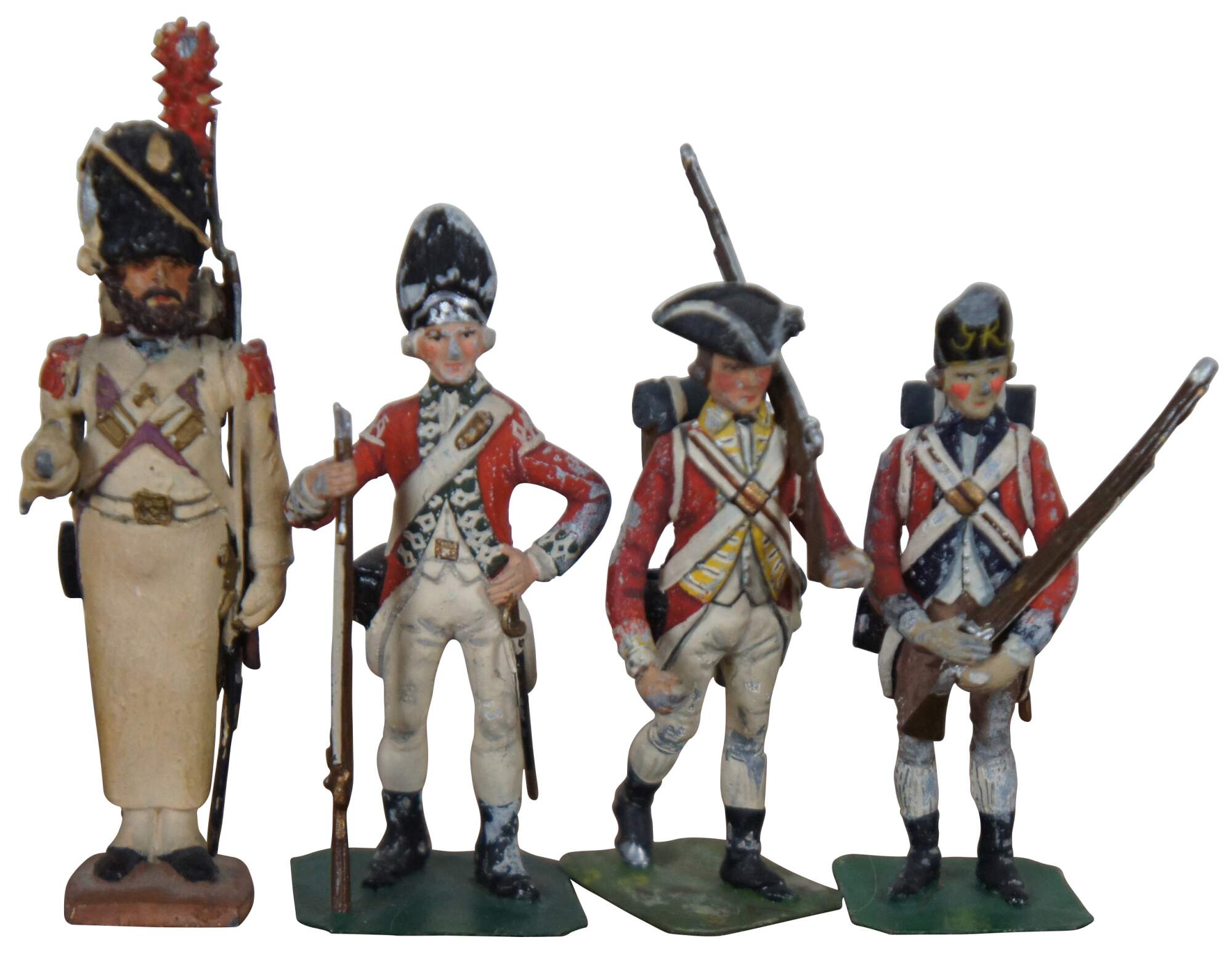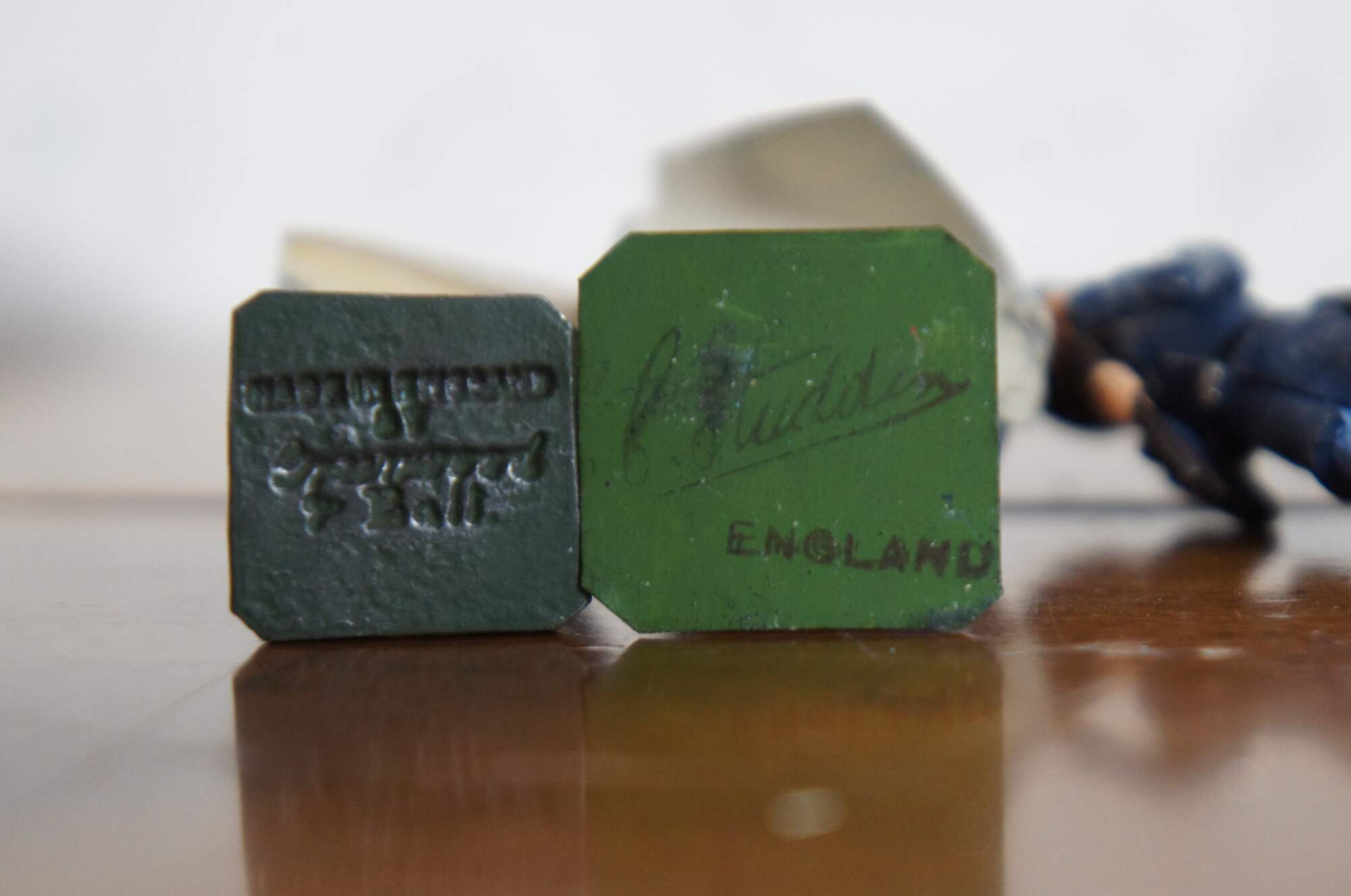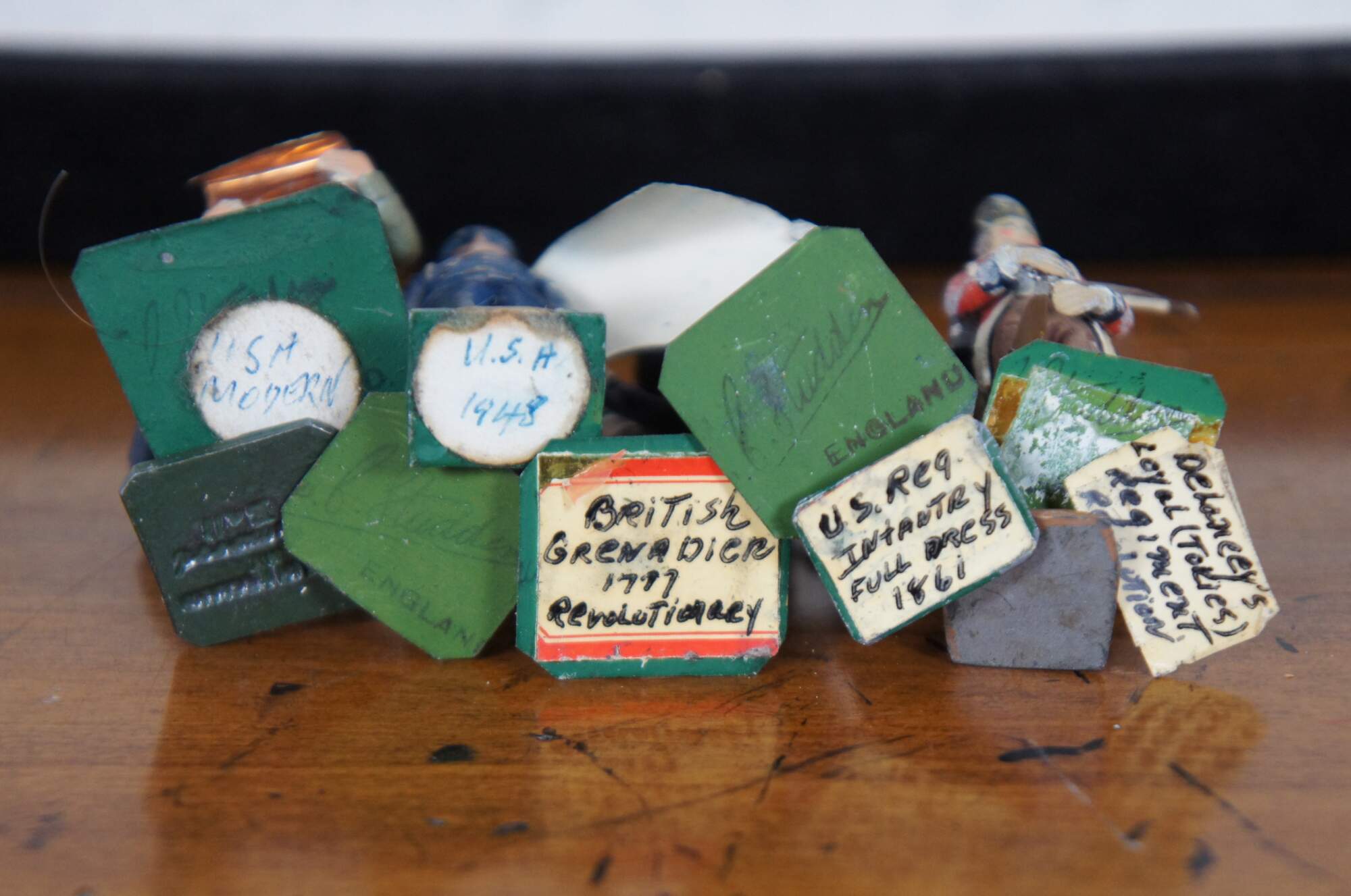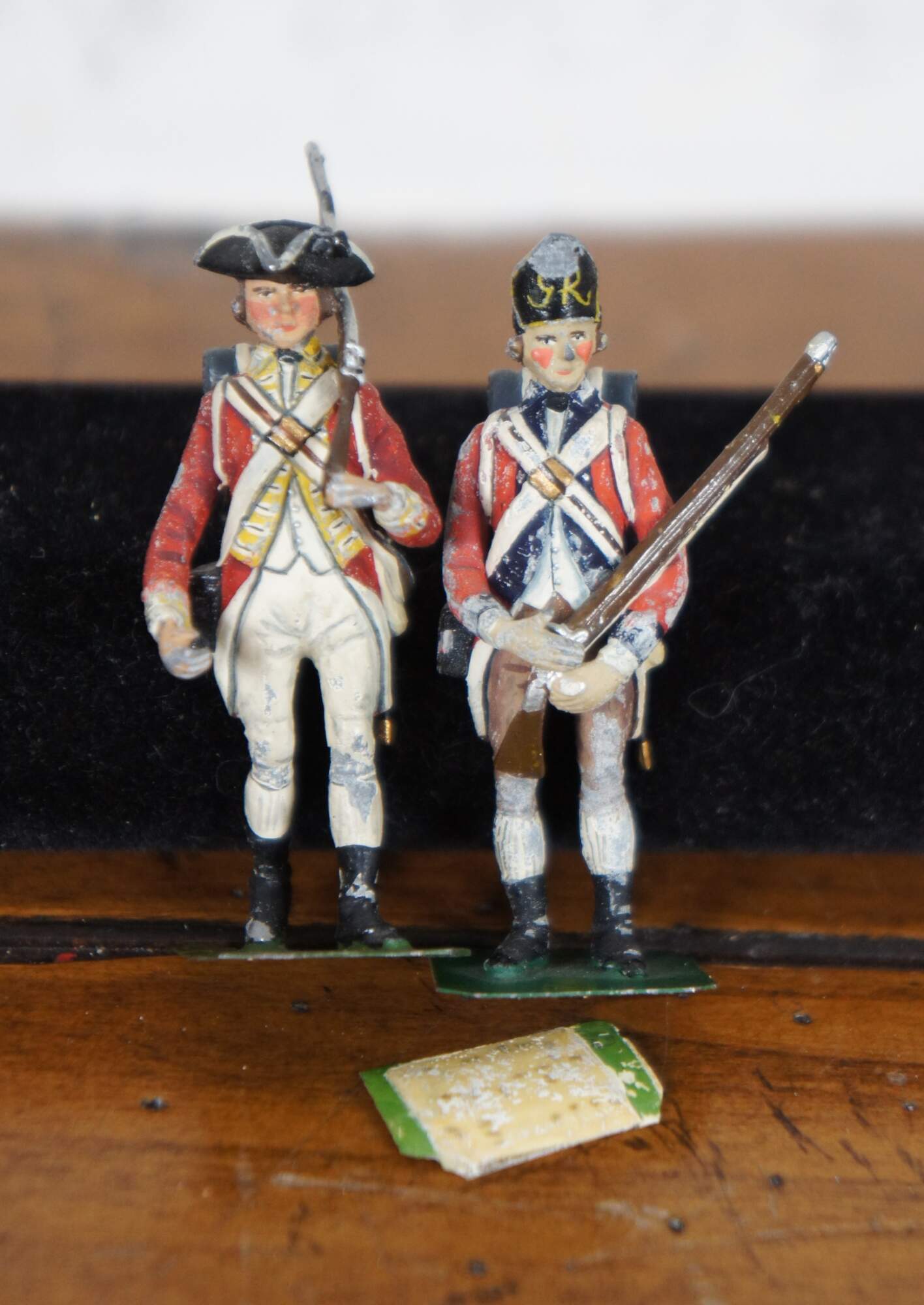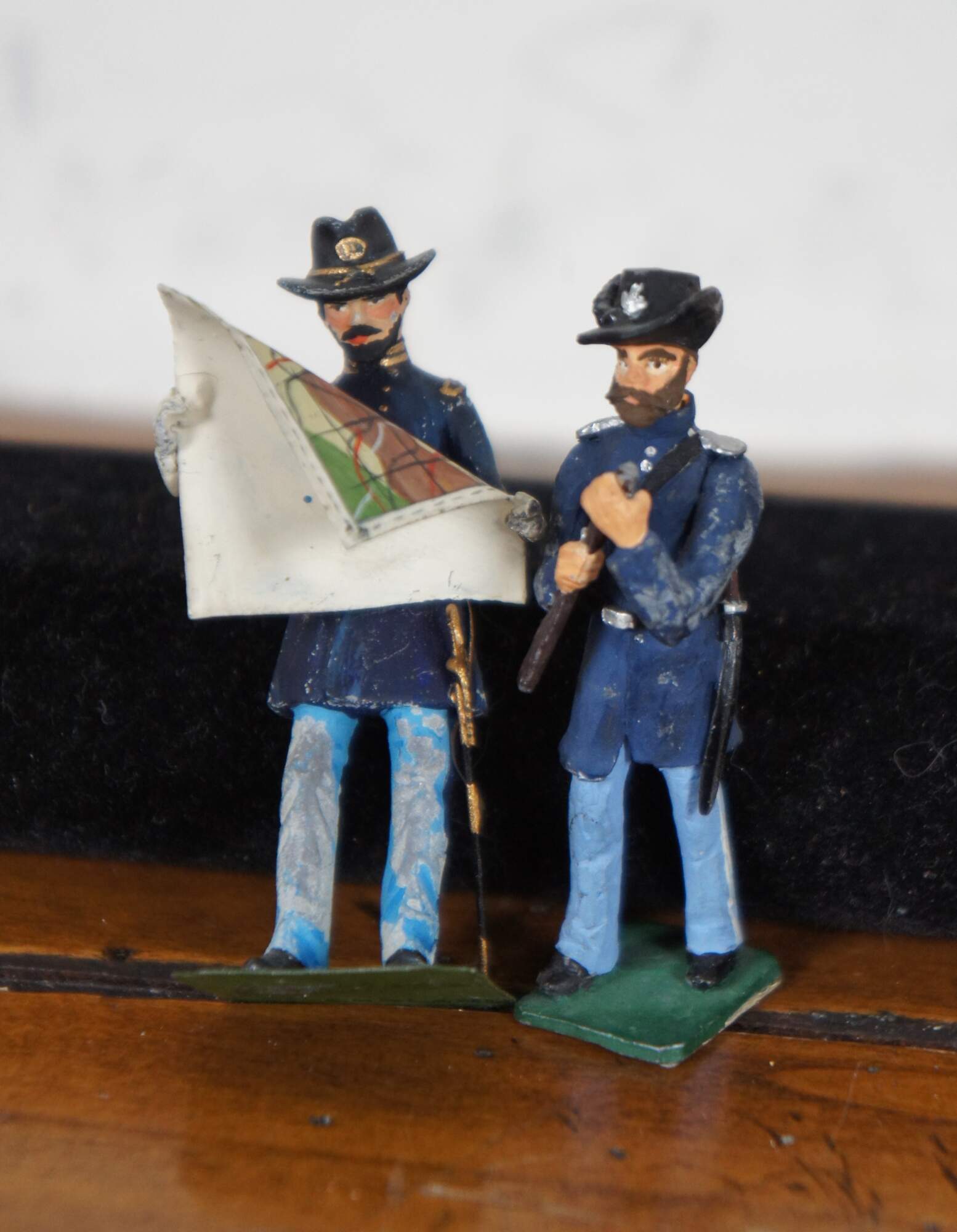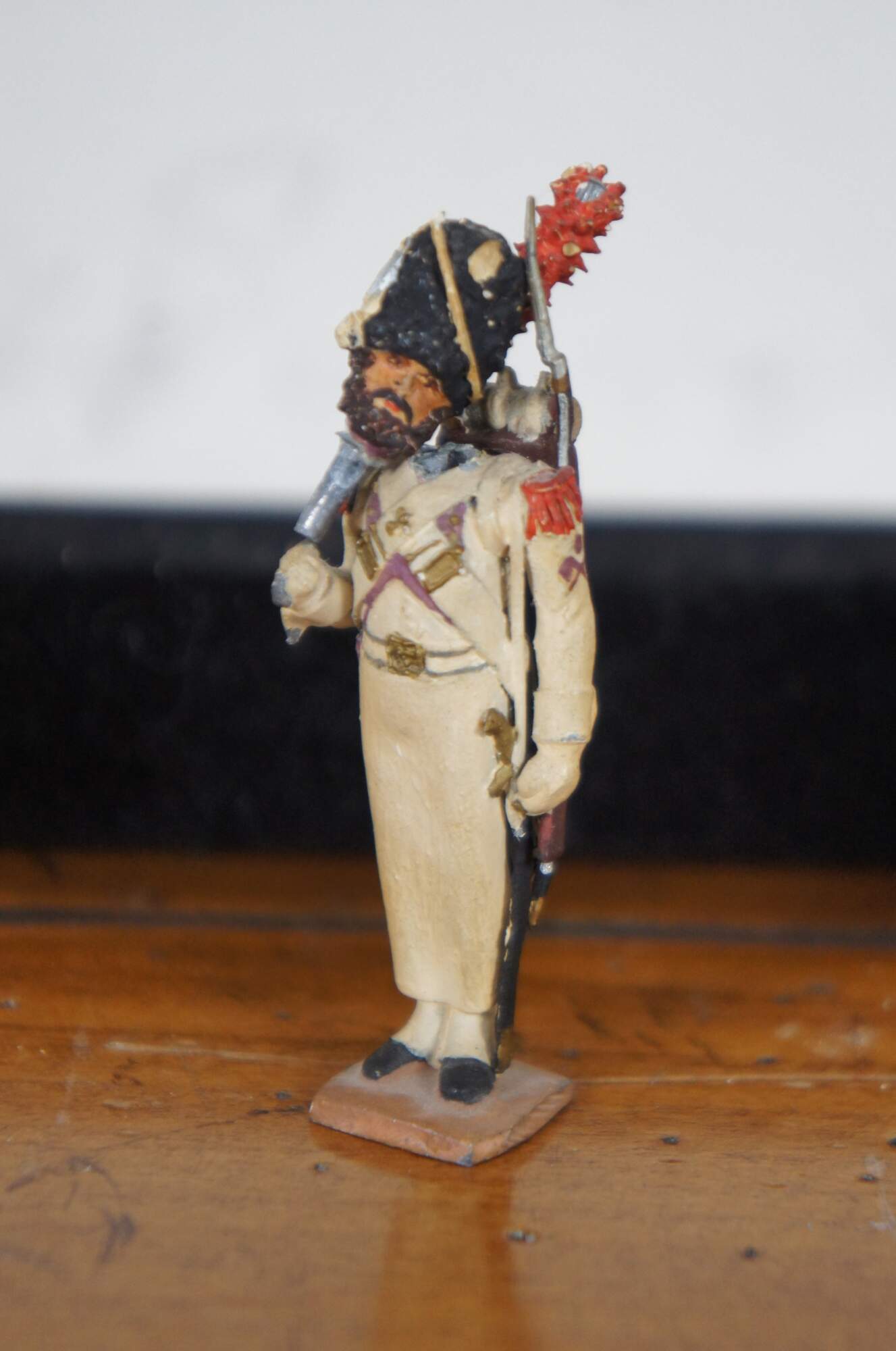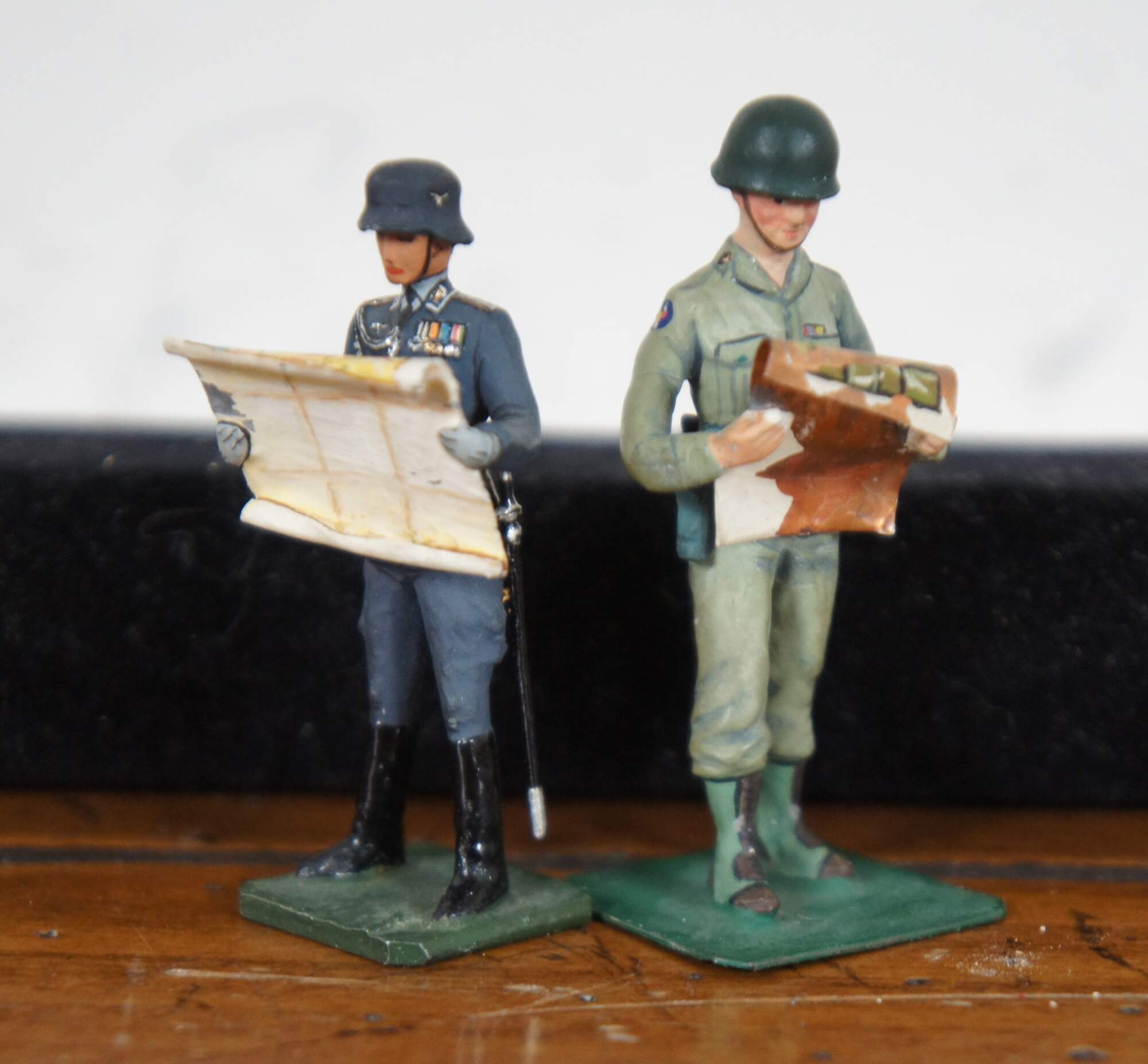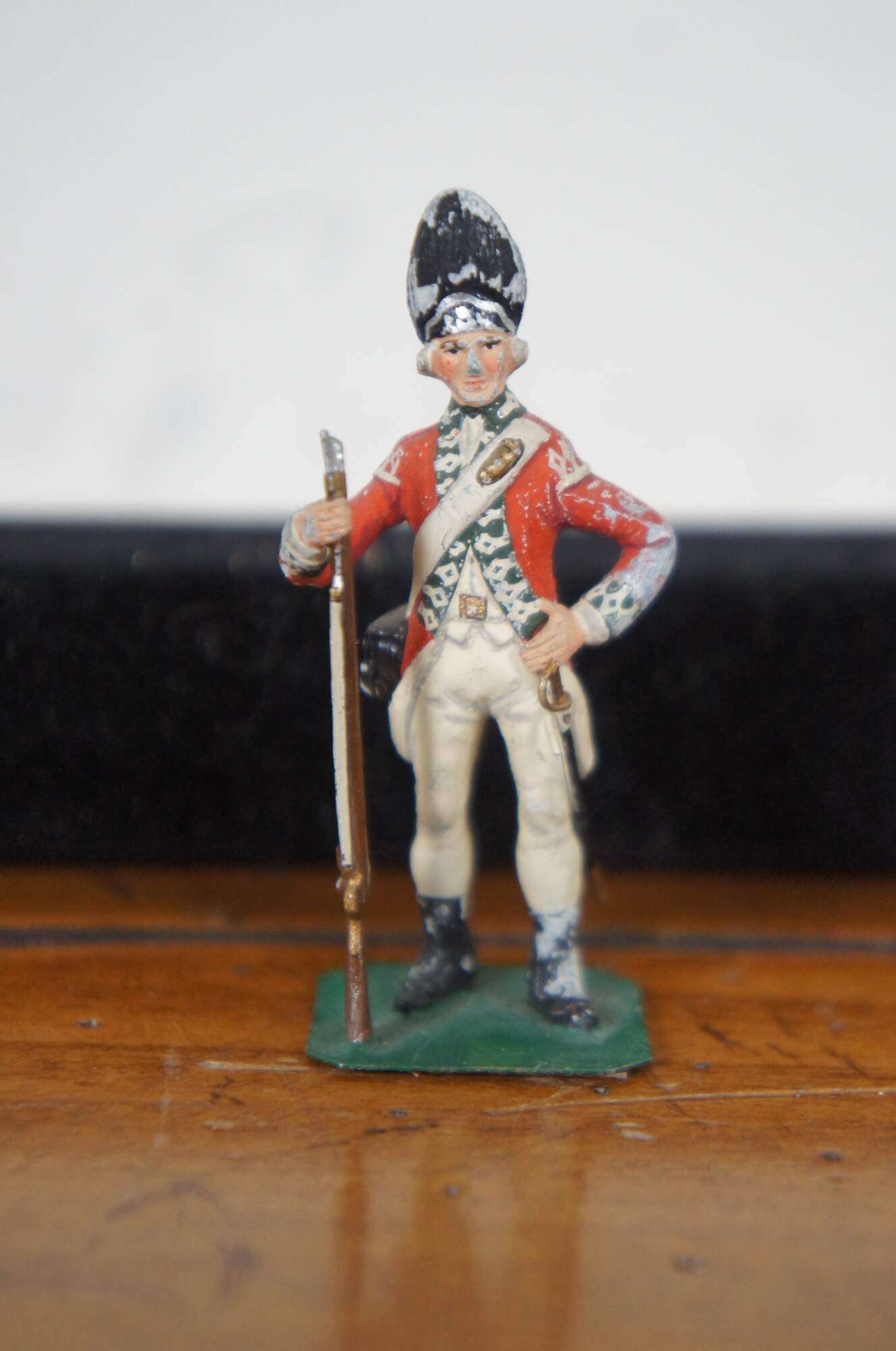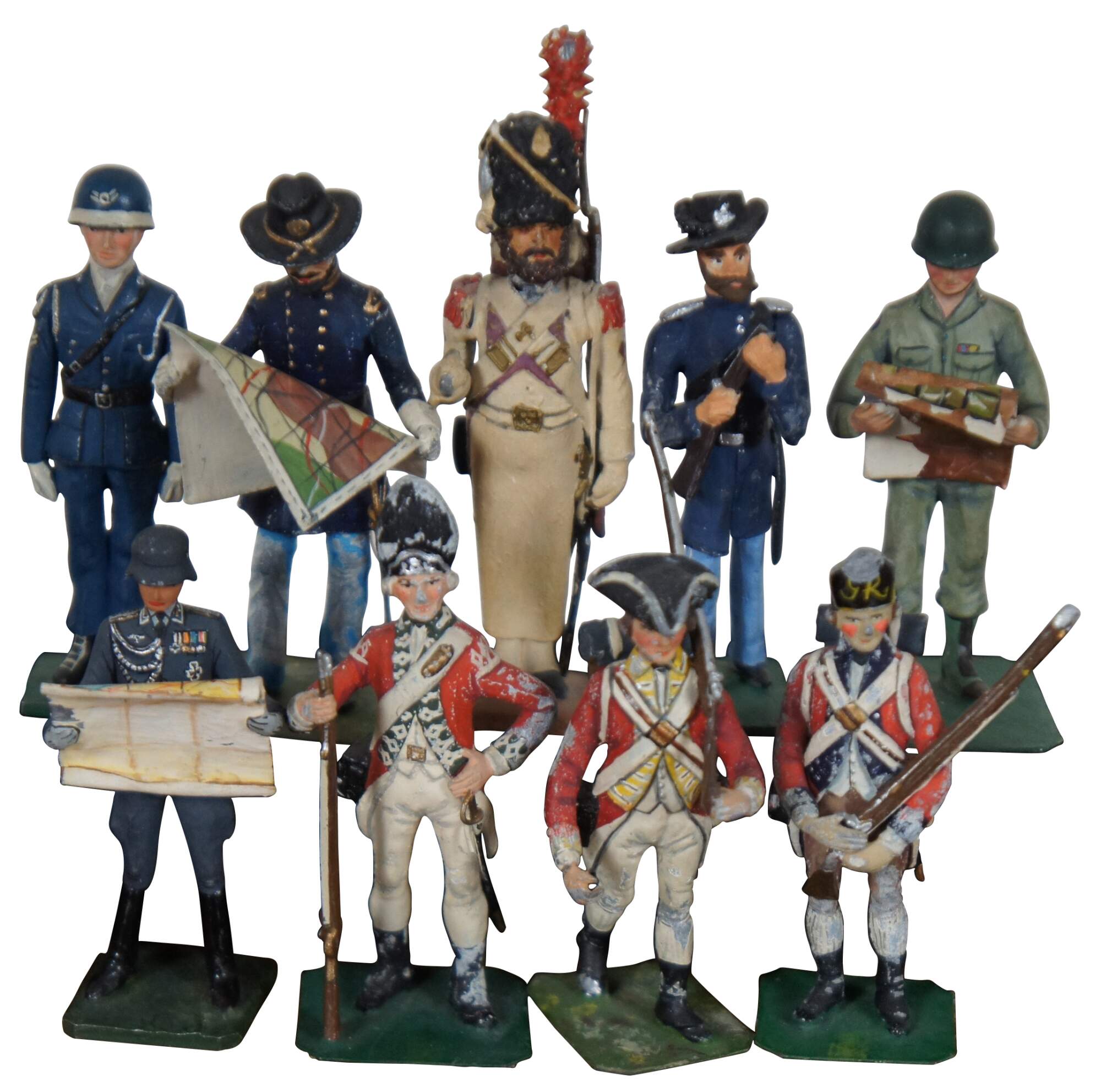
9 Lead & Pewter Military Figurines Toy Soldier Officer Stadden Greenwood Ball 3"
Sold
Shipping:
Free Shipping Included
Delivery:
Estimated 2-15 Business Days
Payments:
Credit Card, Check, Cash, PayPal, Apple Pay, Venmo
Returns:
30 Days 100% Money Back Guarantee, Buyer Pays Return Shipping
Description
Lot of nine vintage and antique pewter / lead toy soldiers representing a variety of eras from the Revolutionary War to post-World War II; five are by C.C. Stadden (British red coat with a peaked cap hand over sword and leaning on a musket, labeled “British Grenadier 1777 Revolutionary”/ British red coat with peaked cap holding a musket, labeled “Delaney’s Loyal (Tokies) Regiment Revolution”/ Revolutionary War era British red coat with a musket on his shoulder and a tricorn hat / post WWII soldier holding a map, labeled “USA Modern”/ Civil War era Union Cavalry officer with a sword holding a map), one by Greenwood and Ball (World War I era German soldier with a sword on his hip reading a map), and three uncertain (Civil War era Union soldier in a slouch hat and holding a rifle, labeled “US Reg. Infantry Full Dress 1861”/ American soldier at attention in a blue uniform, labeled “USA 1948”/ Napoleonic French(?) Imperial Guard grenadier). “Greenwood & Ball was started in 1938 by John Greenwood (sculptor) and Katherine Ball (painter). Katherine Ball left the company in 1961 to get married. The company was one of the first to start selling 25mm scale figures. John Greenwood sold the company to W.F. Pearce in 1971 and the company name carried on as a brand. The majority of the 25mm figure ranges were most recently owned by Amazon Miniatures. Other sculptors to work for them included: Al Charles, John Braithwaite, Cliff Sanderson, and John Tassell.” “Charles C Stadden (always known to friends and family as Chas) was born in Leytonstone, London on 12th June 1919. His parents were Francis Stadden and Emily James who had been married on 10th February 1912 in West Ham Registry Office. Francis Stadden had served in the Middlesex Regiment and the Devonshire Regiment during WW1 attaining the rank of Company Sergeant Major. In peacetime he was employed as a stationers manager for Strakers of London. Chas had three older brothers, Frank, Arthur (always known as Gyp) and Victor (Vic) and a younger sister, Pearl.
Having such a background of military service must have made an impression on the four young Stadden boys. Two of Emilys sisters were married to servicemen, and while Chas was a young boy his mother had taken him on visits by train to Chichester where his Aunt Louise lived while her husband Augustus (in the RAMC) was stationed at the barracks there.
His childhood was a happy one living in Epsom Road, Leytonstone, close to Epping Forest, and then during the 1930’s at Gordon Road, Wanstead. He was educated at Canterbury Road School in Leyton and had an interest in things military from an early age. Christmas presents were usually toy soldiers, and his father used to bring Chas postcards depicting military uniforms when he came home from work. Another lifetime interest was steam trains, which began when Chas and Vic used to play at Snaresbrook level crossing pulling on the railings pretending to be signalmen. Chas left school at 14 (despite gaining an art scholarship) to work as a Liftboy at Martins Bank, 68 Lombard Street, London. He was dismissed within two years for causing £400 worth of damage to one of the lifts while 'larking about' with one of the heavy ledger trolleys. To avoid telling his parents of being given the sack he decided to join the military at Stratford while still underage.
Chas thought he was destined to be a trumpeter in the Royal Artillery and lasted 40 days until his mother Emily managed to retrieve him. His second spell of civilian employment as a switchboard operator also ended in dismissal due to ‘larking about’. At this time Chas was a keen racing cyclist and obtained a summer job building racing bikes which was his introduction to light engineering. Although he enjoyed this work, at the end of the season he was laid off and had to take work as a parking attendant and nightwatchman.
In the summer of 1939 he returned to the cycle trade until called up to military service under the Militia Act at the age of 20, enlisting on 1st December. He passed the medical A1 fitness but was found to be slightly shortsighted. This meant that he was unable to join the infantry (preferably the Lancashire Fusiliers) as he wanted but was instead sent to restart his military career at the 7th Drivers Training Centre RASC, Luton.
During his full time military service Chas was with the Royal Army Service Corps (Horse Transport), The Cyprus Regiment and the Royal Fusiliers.
By the time he was demobilised in 1946 he was a Sergeant in the Royal Fusiliers and had seen active service at Dunkirk, Eritrea, Abyssinia, Crete, Syria, Sicily and Cassino, Italy.
On the reconstitution of the Territorial Army in the post-war period he served as a Sergeant in the Royal Fusiliers T.A. and then the Royal Sussex Regiment T.A., Littlehampton until 1967.
Charles Stadden had been interested like most youngsters in model soldiers, but in 1951 he decided to turn his hand to their commercial
production. The experience gained in light engineering before the war assisted him in revolutionising some of the manufacturing techniques.
Whilst still producing ‘master’ models for manufacturers he allowed his artistic talents to return to drawing and painting and the current
interest in military uniforms made his work much sought after. His name is included with the well known military artists of an earlier era such
as Harry Payne and Richard Simpkin. Over the years Charles Stadden produced military figurines in 25mm, 30mm, 54mm, 85mm and 90mm sizes as well as larger sculptures and wood carvings. He could produce 54mm pewter master figure from scratch in less than a day and a 25mm pewter master figure in a few hours.
Although most well known for military subjects, he produced many other pieces for the toy and giftware trades including sculptures of film and pop stars. He created masters for Subbuteo sports games, Triang Hornby railways and for Scalextric racing cars.
He was just as productive with his artwork. His oil and watercolour paintings adorn the walls of many military museums, offices and private collections. Others have been available as prints, postcards, first day covers and Christmas cards. He has written and illustrated books on military history.
Although he ceased to make figures around 1995, he was still painting watercolours until a few weeks before he passed away at the age of 83 years.”
Condition
Good Overall - One loose head; one broken rifle barrel; gentle wear to paint
Dimensions
Tallest - 1” x 0.75” x 3” (Width x Depth x Height)
